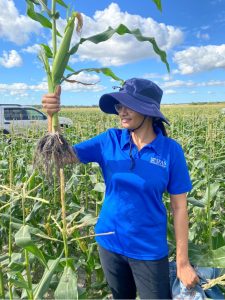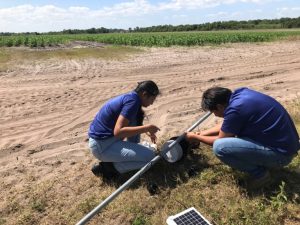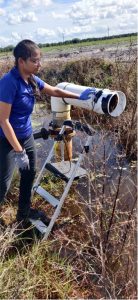
FORT PIERCE, Fla.—Florida vegetable growers rank second overall in the United States for total vegetable sales and third for corn production. Fresh corn contributes more than $1 million annually to the state’s economy. While corn sales are a profitable commodity, Akshara Athelly shows the producers how new technology can save money through irrigation practices.
“Florida vegetable producers are highly successful,” said Athelly, a Ph.D. candidate at the University of Florida Indian River Research and Education Center (IRREC) in Fort Pierce, Florida. The center is part of UF’s statewide Institute of Food and Agricultural Sciences, or IFAS. “My research focus on the assessment of smart technology adoption for irrigation scheduling among vegetable producers, mostly sweetcorn. I transfer my scientific findings to county extension faculty and together we show producers how the technology will optimize their production operations.”
The UF/IFAS Smart Irrigation and Hydrology Laboratory at IRREC
Sandra Guzmán, an agricultural and biological engineering assistant professor, leads a team of scientists at the Smart Irrigation and Hydrology Laboratory at IRREC, where IrrigMonitor, a centralized tool for irrigation management, used by growers, was configured. Guzmán supervises Athelly’s work.
Guzmán said Gregory Conde, an associate postdoc at IRREC, has been instrumental in integrating machine learning into IrrigMonitor, enhancing the tool’s capability to make irrigation recommendations.

“Gregory’s work in scheduling seepage irrigation in Central and South Florida is groundbreaking, addressing the unique needs of our South Florida producers,” said Guzmán. “Akshara’s efforts in making IrrigMonitor and other smart tools accessible to producers are crucial for expanding our scientific solutions. With the data captured from the sensors, and the irrigation recommendations obtained from IrrigMonitor, one sweetcorn producer saw a 40% decrease in the water he used for irrigating his croplands with seepage irrigation.”
Algorithm development for artificial intelligence
“We have developed algorithms that integrate soil physics and irrigation knowledge with real-time data to help growers optimize their irrigation practices,” Conde said. “Our preliminary results indicate that growers can enhance crop yields and save more than 30% of the water used, thereby saving money and reducing environmental impact. These algorithms are now being incorporated into IrrigMonitor, and the potential to expand these benefits to more growers drives our ongoing research and development.”
Soil moisture sensors
Soil moisture probes resemble a radar machine with sensors distributed across 24 inches into the soil. As part of her research Athelly, Conde and the team collaborate with three sweetcorn producers. Akshara learns about producers’ operations and installs soil moisture sensors in their crop fields. The sensors collect data that reveals how much moisture is present in the soil, and this data along with other sources of information is processed in IrrigMonitor by Conde.
“From the graphs and charts created in IrrigMonitor, we assess irrigation needs to optimize the crops’ management,” said Athelly. “We use weather data and forecasts to determine how much irrigation the crops will need for several days in advance.”
Collaborations with UF/IFAS Extension agents
Athelly collaborates with UF/IFAS extension agents who work directly with the food producers in central and south Florida. The agents relay recommendations to the growers on when crops need irrigation and for how many hours to apply irrigation. The farmers receive emails every three days that impart specific instructions for their farm operations. Often, rain forecasts are a part of the recommendations, and the need for irrigation is much lower.
Six million gallons of water saved in a single season
Athelly references a producer with whom she works. “After using IrrigMonitor and our recommendations he saved six million gallons in a season.”

Seepage irrigation
Irrigation practices are unique to South Florida due in large part to the shallow water table. For this reason, water is accessible near the soil level, and growers rely on seepage irrigation practices, or a system of canals that includes a wide canal and multiple narrower canals. The canals are flooded with water and rise to the ground level, reaching the crops at the root level, Athelly said.
“Growers know their land and they have been growing crops for centuries,” Athelly said. “I am to discover paths for them to show them how to make their operations even more profitable with the new technology. It’s not something the growers are used to relying on, and often, they believe the cost for the sensors and data production will be too high—but then they see the savings, and they want to adopt the sensors in their fields.”
Further, Athelly said good irrigation management preserves the corn crop’s nutrients. “Too much water will wash away valuable nutrients in the corn.”
Athelly said the IRREC Smart Irrigation and Hydrology Laboratory team is working to develop a mobile phone application (app) for growers to use the soil moisture sensors and the data the sensors produce. The app, once completed, will provide similar advisories Athelly and the extension agents send to the corn growers.
“Right now, I am talking like an app but in the future, we will have an app for growers to use,” said Athelly.
Athelly said Guzman’s Smart Irrigation team aims to increase irrigation management using data-based solutions among producers and demonstrate these solutions value for crop production.
“Reducing irrigation costs is one great advantage, but the ability to produce crops with higher nutritional value is breaking ground on an even deeper level,” Athelly said.
 5
5
